 Heirloom Muscari
Heirloom Muscari
If you are looking for heirloom flower bulbs, you’ll be thrilled to find out that there are several varieties of Muscari that date back to as long ago as the 16th century!
1554 M. ambrosiacum
1878 M. armeniacum
1871 M. aucheri Blue Magic
1596 M. comosum
1612 M. comosum plumosum
1886 M. latifolium
1884 M. paradoxum
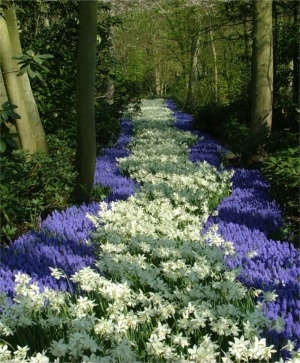 Horticultural Zone Hardiness
Horticultural Zone Hardiness
Each variety of Muscari has its own hardiness zone requirements that should be considered when selecting varieties for your garden. If your garden is in a horticultural zone that is either too cold or only marginally appropriate, you may want to apply no more than a 2" layer of mulch after the ground surface freezes in the fall. The mulch should trap the cool temperatures into the soil, not warmth. Mulch helps to protect the bulbs from arctic temperature spikes. Good mulching mediums include straw, salt marsh hay or oak leaves. In the spring, you can loosen the mulch in the area in which the Muscari will be sprouting. Mulching is particularly good for less hardy varieties like Muscari ambrosiacum and M. paradoxum that thrive in horticultural zones 5 through 8.
Bulb Inspection
Check your shipment against the packing slip and make sure that everything is as it should be. Occasionally, bags of smaller bulbs may be placed in the inner boxes of other bulbs to reduce jostling during shipment. If you can’t find something, open all of the inner boxes. If there is a discrepancy, please call us immediately so that we may resolve it with you. Since every bag or box of bulbs in your order has been scanned using its UPC barcode, we can usually tell you in which box each variety is located.
Inspect your bulbs carefully. We make every effort to ship you only healthy, firm, top quality bulbs. Muscari bulbs look different from other types of flower bulbs like Tulips or Narcissi. It is natural for some types of bulbs, particularly Muscari, to develop a transportation mold when they are exposed to oxygen. It is a natural gray-blue-green mold that occurs when they are exposed to air, and that disappears as soon as the bulbs are planted. The soil naturally wicks it away. If you prefer, you may spread the bulbs out in the sun, or brush it off with a paper towel, although it is not necessary.
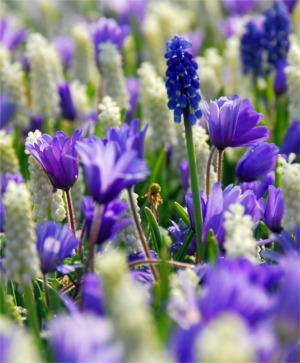 Little cuts, scars, discolored exteriors and dimples are normal marks from the flower bulb harvesting, cleaning and sizing processes in the Netherlands. Some bulbs may have a fully intact, papery skin while others have partial skins, and others may be skinless. The existence or condition of the skin has nothing to do with the performance of the bulb. The most important factor is the way that the bulb feels. As long as the bulb is firm, it is a good and viable bulb. Some bulbs may already have tiny baby bulbs developing on the basal plate (root base) of the bulb while others may even have a little top shoot. Some bulbs are prettier than others, but you can rest assured that all of the flowers will be gorgeous!
Little cuts, scars, discolored exteriors and dimples are normal marks from the flower bulb harvesting, cleaning and sizing processes in the Netherlands. Some bulbs may have a fully intact, papery skin while others have partial skins, and others may be skinless. The existence or condition of the skin has nothing to do with the performance of the bulb. The most important factor is the way that the bulb feels. As long as the bulb is firm, it is a good and viable bulb. Some bulbs may already have tiny baby bulbs developing on the basal plate (root base) of the bulb while others may even have a little top shoot. Some bulbs are prettier than others, but you can rest assured that all of the flowers will be gorgeous!
Bulb Size
Each variety of Muscari makes its own special top size bulb. Some are as small as 5 centimeters wide, while others are 9 centimeters wide. If you find that one bag of Muscari bulbs contains larger and smaller bulbs, it is a glass half full or half empty issue. Each of the bulbs is, at a minimum, the top size specified for that variety. They are sized on conveyor belts in the Netherlands that have holes the centimeter size just below the top size measurement. Smaller bulbs fall through these holes and are not included in our stock. All of the larger bulbs are included in our stock, and, as a result, there can be size variation. But it is definitely a glass half full! (If any variety in any season produces a smaller top size bulb than expected, we note it on our website. If a price change occurs as a result, we post the new price and make an adjustment on every order.)
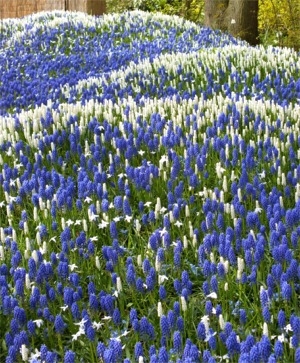
Bulb Storage Before Planting
After you’ve received your order and inspected it, keep the exterior carton and the inner boxes open to give the bulbs some air. All bulbs love good air circulation. Store them in a cool, dry place with low humidity, away from heat, frost and strong sunlight at about 50°F to 70°F. Never put flower bulbs in the freezer! Poor storage conditions could cause bulbs to dry out, or to become moldy.
Select and Prepare the Planting Site
You’ll need about nine bulbs per square foot. Square footage is determined multiplying the planting site’s length by its width.
There’s no end to the creative ways in which one may use the many forms of Muscari. It’s fun to blend white and blue Muscari together into a little mixture, or to combine Muscari with other bulbs like Narcissus Tête à Tête or a contrasting color of Anemone blanda. You could also make some of the Keukenhof's design ideas your own: plant a river of Narcissus Thalia flanked with thick ribbons of Muscari armeniacum, or a meandering carpet of our Magic Carpet Tulip Mixture edged by thick borders of Muscari. Winding masses of Muscari can connect spring beds. Muscari is also a terrific underplanting for naturalizing Narcissi.
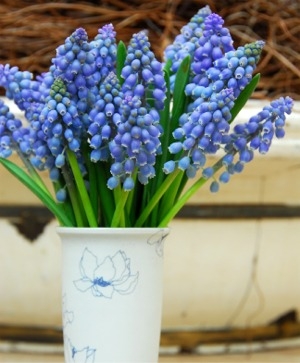 All Muscari require neutral pH and well-draining soil. The best soil is a sandy loam. For clay soil, break up the clay about a foot deeper than the planting depth of your bulbs and amend the bed with well-aged neutral-pH compost. For excessively sandy soil, amend the bed with peat moss and aged leaf compost.
All Muscari require neutral pH and well-draining soil. The best soil is a sandy loam. For clay soil, break up the clay about a foot deeper than the planting depth of your bulbs and amend the bed with well-aged neutral-pH compost. For excessively sandy soil, amend the bed with peat moss and aged leaf compost.
Please do not ever add horse manure, chicken droppings, mushroom compost or other hot manure or compost to your flower bulb beds. If you would like to add compost you’ve made yourself, please make sure that it has a neutral pH and is completely decomposed and healthy. Partially decomposed compost can spread fungal disease, such as botrytis blight and nasty pests. What is good for vegetables is not necessarily good for flower bulbs.
Muscari require full to partial sunlight.
Easy to Plant
Muscari bulbs are so easy to plant and are low maintenance. We'll ship you the bulbs in time for planting in your garden in the fall, once the ground has chilled down to about 55°F, after about two weeks of sweater weather when night time temperatures have hovered in the 40s. This is the best time to plant Muscari bulbs. Flower bulbs do everything in response to temperature and sunlight.
 Plant Muscari bulbs 5" deep and 3" to 4" apart. Please do not put anything in the bottom of hole that you’ve dug for the bulbs. Nestle the bulb into the hole, fill in the hole with soil to the level of the bed, and tamp down the soil lightly, making sure that individual holes are no longer apparent and that the garden bed surface is level. This will help to prevent water from filling up any of the individual planting holes excessively. All flower bulbs hate to get wet feet.
Plant Muscari bulbs 5" deep and 3" to 4" apart. Please do not put anything in the bottom of hole that you’ve dug for the bulbs. Nestle the bulb into the hole, fill in the hole with soil to the level of the bed, and tamp down the soil lightly, making sure that individual holes are no longer apparent and that the garden bed surface is level. This will help to prevent water from filling up any of the individual planting holes excessively. All flower bulbs hate to get wet feet.
If you would like to do a layered or lasagna planting, first plant the Narcissi or Tulips to the proper depth and spacing, then cover them with enough soil to bring the Muscari planting depth to 5". Then, place all of the Muscari bulbs over the surface (3" to 4" apart) and cover them with soil even to the surface of the bed. The Narcissi or Tulip bulbs will grow through the Muscari planting and the Muscari will appear as a vibrant underplanting.
Fertilizing
Never put anything, including fertilizer, in the bottom of each bulb planting hole. Plant the bulbs to the proper depth and spacing, tamp down the soil and broadcast a 5-10-5 or 4-10-6 granular organic fertilizer over the surface of the bed as if you were feeding the birds.
While all flower bulbs are nature’s perfect little packages and will bloom beautifully the first year, we recommend broadcasting fertilizer three times a year for all perennial and naturalizing flower bulbs. First at the time of fall planting to help grow the roots, second when the sprouts emerge in the spring to help nourish the foliage and flower, and finally when the flowers start to die back, to help feed the bulb itself. (Bone meal is incomplete nutritionally and can attract animals to some varieties of bulbs.)
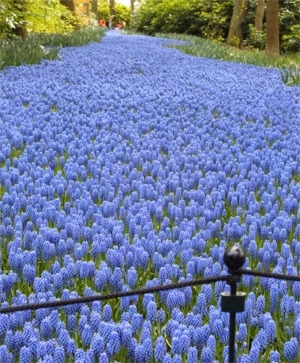 Do Not Plant Muscari in Exterior Containers or Raised Beds
Do Not Plant Muscari in Exterior Containers or Raised Beds
Flower bulbs should never be planted in outdoor containers, window boxes or raised beds where bulbs experience temperature spiking and repeated cycles of freezing and thawing. This results in root growth failure, root system destruction, frozen bulbs and/or bulb rot from poor water drainage. Flower bulbs must have a consistent cold winter temperature with good water drainage in order to produce a mature root system that will permit foliage growth and flower production in the spring.
Bloom Times, Size and Color
The bloom time listed for each variety is for horticultural zone 5 in normal spring conditions. The warmer the horticultural zone, the earlier flower bulbs will bloom. The colder the horticultural zone, the later flower bulbs will bloom in the spring.
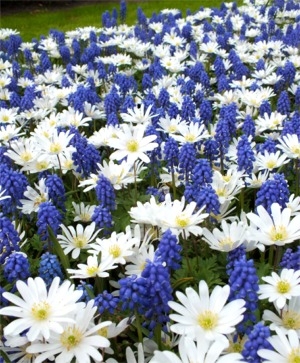 Flower bulbs do everything in response to temperature, sunlight and site conditions. Bloom times, heights and colors are approximations affected by temperature and site conditions regardless of the calendar date. If it is a warm spring, bulbs will bloom earlier. If it is a cold spring, bulbs will bloom later. If it is a long cool spring, followed by rapid warming, you may find odd bedfellows: earlier blooming Galanthus flowering right along side later blooming Crocus, Species Tulips and Narcissi. Each spring can offer a different sort of garden surprise party.
Flower bulbs do everything in response to temperature, sunlight and site conditions. Bloom times, heights and colors are approximations affected by temperature and site conditions regardless of the calendar date. If it is a warm spring, bulbs will bloom earlier. If it is a cold spring, bulbs will bloom later. If it is a long cool spring, followed by rapid warming, you may find odd bedfellows: earlier blooming Galanthus flowering right along side later blooming Crocus, Species Tulips and Narcissi. Each spring can offer a different sort of garden surprise party.
In the event of a mild winter or a warmer-than-usual spring, flower bulbs that have emergent stalks with set buds may bloom early, small and short, although they will likely grow taller and larger as temperatures moderate. Temperature spikes can also affect mature root development, the actual form of the flower or the process of flower color maturation.
Fall Foliage
Muscari is one of the few varieties of flower bulbs that sends up an extra round of foliage in the fall. It’s natural, you needn’t worry or do anything with it or to it. Just ignore it. If you’re going to mulch, do not apply more than a 2" layer of mulch over Muscari until after the surface of the ground freezes. If you want to avoid this phenomenon, select Muscari paradoxum, which is a descendant of Bellevalia.
 Spring Care
Spring Care
The most important thing to remember in the Spring is to enjoy your garden! Create big and little reasons to be outside, hold an annual Spring flower party, take notes on what you love and how all of your bulbs are doing, and take photos of where you need to plant more. Don’t forget that Muscari make good cut flowers too! They may be small compared to Tulips and Narcissi, but they are still lovely in little bud vases where you can enjoy their delicate beauty and wafting hint-of-the-grape fragrance.
Once Muscari bloom and start to die back, make sure to keep the foliage going until it dies back naturally. A maximum period of photosynthesis allows the bulbs to regenerate for the future. When Muscari is extremely happy where planted, it can naturalize by both bulb offsets (baby bulbs on the sides of the mother bulb you’ve planted) and even self-sowing seed. When you are planting your Muscari bulbs in the fall, you can see already the development of little baby bulbs on the bases of some of the mother bulbs that we’ve shipped you.
Blooming in April and or May in a horticultural zone 5, deer- and rodent-resistant Muscari grow from 4" to 12" tall, depending on the variety, with short grass-like foliage. After the flowers die back, the foliage continues to grow, which is a good thing: a prolonged period of photosynthesis helps bulbs grow and multiply with little baby offshoots for even more flowering spikes in future years. Once the foliage dies back, it may be raked and discarded.
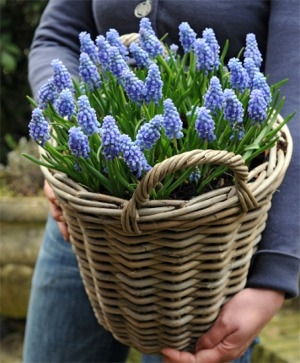 Forcing
Forcing
Muscari are also good for forcing indoors over the winter. In mid-October, before potting the bulbs, prechill them in their bag or box at a consistent, dark 38°F to 45°F for four weeks. Get the pots ready. Remove the bulbs from the fridge, pot them up and put them back in the fridge before they lose their cool. Chill the pots for another four weeks at a consistent, dark 38°F to 45°F with moderate watering. This two-step process should help to reduce excessive foliage production. Bring them out into the house~they will bloom two to six weeks later. Once the bulbs are forced, their vitality is spent and the bulbs may be discarded. Muscari make good cut flowers too.
Trouble Shooting
If Muscari are yielding more foliage than flowers, it indicates a root system issue. A mature planting may need to be dug up in the fall and transplanted to the original depth and spacing after carefully separating the bulbs that may have been strangling themselves.




